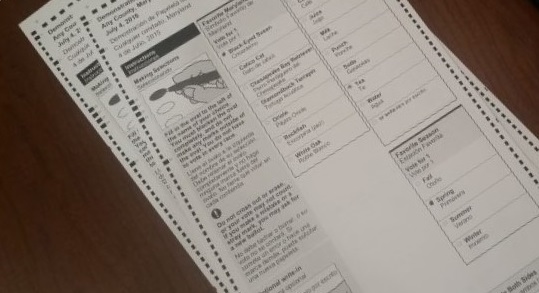Opinion: Maryland Needs Multi-Member Proportional Districts, Not Single-Member

Recently, Comptroller Peter Franchot and others have argued for single-member districts for the House of Delegates in Maryland. This would be a grave mistake. Single-member districts necessarily reduce voter representation, disenfranchise more voters and narrow the span of political ideals represented in government.
The ideal bicameral legislature at the state level would use a single-senator, multiple-delegate configuration, as Maryland does now. Marylanders would vote via single transferable vote, a proportional ranked choice voting method which ensures fair representation of the diversity of ideals among the voters. This simply requires voters to rank a number of candidates — however many they care for, although voters should ideally find their top three or four — in their order of preference.
So how does single transferable vote work?
Single transferable vote discovers shared consensus among multiple groups of voters by requiring candidates to reach a quota of votes. If voting for three delegates, the quota is 1/4. The number of votes a candidate receives in excess of this determines how much of a single vote is transferred to the next candidate: a narrow win margin means those voters stop impacting the election; while electing a candidate by a landslide retains more voting power so as to not penalize voters who vote for a popular candidate.
In this way, every voter gets one vote, and voters essentially “step aside” after electing a candidate and allow everyone else to vote. More-complex versions of single transferable vote, such as Meek’s Method, ensure the election proceeds as if only the ultimate winners were ever candidates.
Each group of voters with similar political preferences essentially engages in a runoff election among themselves. Under instant runoff voting — a popular form of ranked choice voting for single-winner elections, used in Takoma Park — a dominating group of voters can effectively exclude nearly half of all voters from the election. Single transferable vote discovers these minority groups and empowers them to each select an appropriate representative.
The next question would be how does this compare to single-member districts?
With single-member districts, the winner is selected by either the largest number of voters voting for a candidate (plurality); the dominant group of voters in a runoff (instant runoff voting); or the overall consensus of that district’s voters (Condorcet). The Condorcet method is excellent for electing the state senator, but not for electing three delegates: single-member districts can, at best, find the average; at worst, they become tools of oligarchy and disenfranchisement.
With multi-member districts, the three delegates would represent the diversity of ideals as expressed by the voters. A 60% Democrat, 40% Republican district would tend to elect a progressive and a moderate Democrat, and a Republican; while a 25% Democrat, 75% Republican district would more often select two Republicans and a moderate Democrat.
So single transferable vote is good for voters, but what about candidates?
In single-member districts, the voters have a single candidate who either agrees or does not; while a multi-member district with proportional voting and a heavily mixed-ideology electorate can easily elect a progressive, a moderate liberal (Democrat), and a moderate conservative (Republican). Candidates need only represent the voters who fit their ideology.
Such districts have a space for Democrats like Mike Miller, while also preventing the election of three Mike Millers. If a good one-fourth or more of the voters desire a more progressive candidate, then a progressive candidate can and will be elected. Voters will find a Mike Miller and a Mary Washington to elect and will elect both.
Because of this, candidates need to identify and target voters who share their ideals. A well-mixed progressive and conservative district will elect one of each, and so the progressive need not represent conservative voters, and vice versa — the state senator has the difficult ethical job of considering constituents who disagree strongly on basic ideological terms.
A door-knocking campaign is much more effective because of this, although slates no longer work very well at all. While candidates need only target the constituents who fit their ideology, the three elected delegates will differ starkly, and so only typically only one candidate on a slate of similar candidates will actually be elected. This is an advantage to the voter: a single large voice should not dominate the election and crush the minority voices.
This system does not particularly favor parties or candidates, but rather empowers the voter. It is the voter who matters, and elections must always be about that.
–JOHN MOSER
The writer is an information security engineer, economist and independent policy wonk. He is on Twitter as @structuralecon and runs the Nordic Model USA website.
Did someone forward this to you?
Get your own daily morning news roundup in your inbox. Free. Sign up here.




 Creative Commons Attribution
Creative Commons Attribution